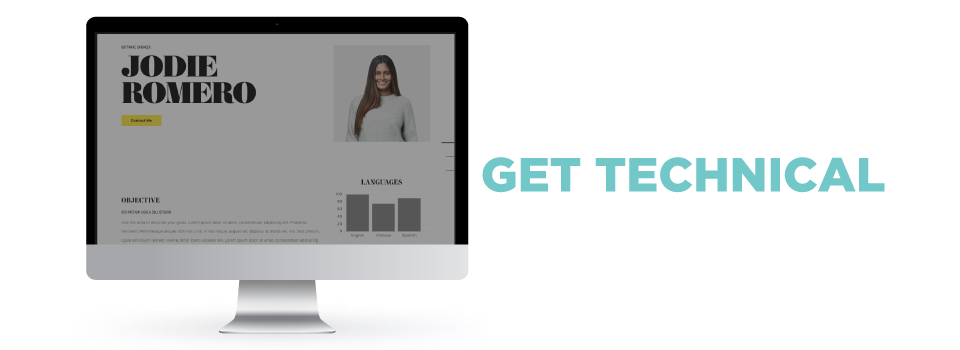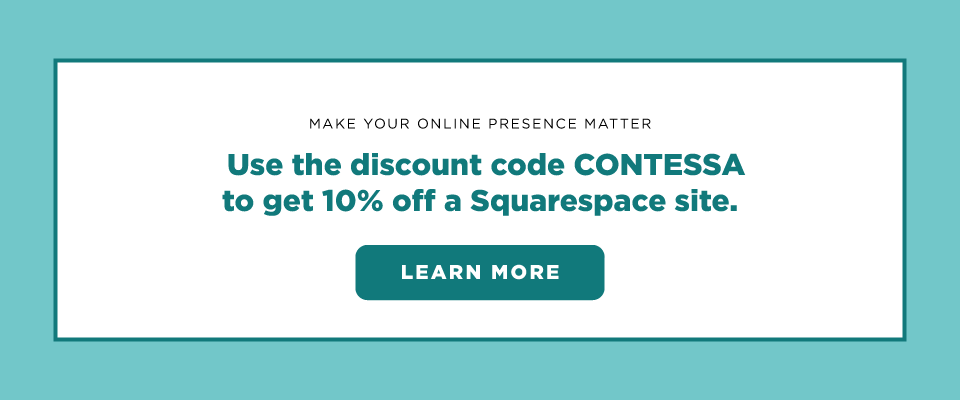This post was sponsored by Squarespace, which makes it easy for anyone to build a personal brand online. Use the code CONTESSA for 10% off of your site.
When you’ve built a website that showcases your talents and your work, you probably want the world to see it.
And guess what? By employing search engine optimization, by
utilizing your social presence, and by implementing a little content marketing, you can open your talents to a nice chunk of the world. Whether you’re a wedding photographer, a digital marketer, or a taxidermist, your people are out there on the web.
Here’s how to find and attract your future customers to your website.
Make Sure Your Website is User-Friendly
If you’ve built a website on
Squarespace, you’re already halfway there when it comes to being mobile-friendly. The next step is to make sure that your website is also user-friendly.
For example, what is it that you want your visitors to know about you when they land on your page? Do you want them to be wowed by a copywriting campaign you completed for a major company? Do you want them to see the beautiful photographs you created for your deep client list?f
When
building your sitemap, showcase your “greatest hits” first. Organize your pages to show the best of the best of what you do.
Pro Tip: Especially when starting out, enact a “less is more” technique. Rather than creating a huge, expansive portfolio of everything you have ever created, tailer it down to the work you’re most proud to present. This will make your website clear and easy to navigate for new visitors.
Research Your Competitors’ Websites
Keyword research is going to be your best friend in making your portfolio website. A great way to start keyword research is to search for your competitors on the web. For example. If you have a photography business in Dallas, search that.
When you find your perceived competitors, take a look at their website. What keywords are they using in their meta descriptions? Do they have a blog attached to their portfolio site? If so, what do they write about?
While we aren’t condoning copying (search engines will punish you for duplicating content, anyway) we are saying that it’s good to take a look at your competitors. Take what they’re doing and do it even better. If they have a blog post detailing the ten best lenses for a digital SLR, make sure you write a blog post detailing the twenty best lenses for a digital SLR.
Speaking of creating awesome content...
Create Unique Longform Content Around Your Niche
When researching your competitors, you might have been inspired to start a blog of your own. Squarespace has amazing templates that lend themselves to creating clean, easy-to-read blogs where you can insert
header tags, images, and helpful links.
Blogging is a great way to attract niche visitors to your site. Make sure to create informative, helpful content around your specific niche.
We aren’t talking about a blog post that details your day and what’s going on in your life. Rather, we are talking really useful content. Research points to long-form content outperforming thinner content. Google loves a blog post or piece of content that is around
2,000 words. Why so long? Longform content gives search engines a better opportunity to learn about your business. Writing longer content gives you the chance to tackle more keywords in your industry, to create more helpful, insightful and often more well-researched content.
If the phrase “2,000 words” scares you, you’re not alone. If you think you can’t possibly write 2,000 words about your specific niche, think again!
There are plenty of fun ways to achieve 2,000 words while being really helpful to your intended audience. Let’s say you’re a copywriter building out your own portfolio and blog. Here are a few ideas for what you could potentially write:
- A Round-Up: This is a long list of helpful advice or pre-written research that you can pull (and link to) from around the internet. An example could be “20 Copywriters Share How They Got Their First Big Break.” To really utilize this method, you could also reach out to whomever you profiled on Twitter or LinkedIn to share the piece. They might share it with their network, too!
- A Listicle: This is a popular method for creating really clickable and digestible content. These listicles usually profile the “best” of something. An example could be “The 25 Best Copywriting Slogans Ever Written.” Like the outreach for a round-up, the listicle can also serve as a great opportunity to get shares and backlinks from those featured on the list!
- How-to Guides: How-tos are also extremely popular, informative, and fun to write. An example of this could be “How to Carve Out 30 Minutes of Writing Time Every Day.”
These are just a few popular examples of ways to write a fun, informative, and clickable piece of long-form content that Google (and other search engines) will LOVE.
Get Technical
There’s a ton of technical search engine optimization you can implement to make sure you’re structure is clean, informative, and search-friendly. You don’t have to be a seasoned web developer to implement them, either.
Lucky for you, Every
Squarespace website or online store comes with a suite of integrated features and useful guides that help maximize prominence among search results. Squarespace’s built-in marketing support will guide you through some of the necessary technical steps you’ll need to take to optimize from the backend.
Create Optimized, search-friendly Images
One of the biggest enemies to great load time (and thus a better Google ranking) are big image files. We know that, especially if your medium is visual, you want the juiciest, most high-resolution photo you can get. Unfortunately, a long load time provides both an awful user experience and a bad rating from search engines.
Make sure to always optimize your images to lend a helping hand to your SEO. Here’s how.
- Make sure to optimize the images so they load fast
- Name your image so that search engines know what they’re looking at. For example, if your page is about your crystal healing shop. Name your images accordingly: “quartz_crystal.png” is a good example of a proper name.
- Provide alt text for your image. This allows you to further place keywords and describe the image. For example “rose quartz crystal from Sara's crystal shop in Dallas, texas”
Make Sure All Text is Optimized + Easy-to-Read
Optimize where you can. If you are looking to rank for a certain keyword, make sure your URL is named accordingly.
If you are diving into blogging, make sure your text is easy to digest. This means creating smaller 2-3 sentence paragraphs, using (optimized) images, utilizing
h1 and h2 tags, and using your best new friends, bullet points.
It’s also worth mentioning that you want your content to be free of spelling or grammatical errors. Always keep in mind that, although search engines are technically robots scanning and grading your content, you ultimately need to be human-friendly first!
Always Be Testing
Whether your personal portfolio is the calling card to your side business or your key to entrepreneurial success, don’t build it and let it sit there! The internet is a living, breathing giant. If you’re interested in pursuing organic, SEO-based growth for your personal website or venture, there are tons of ways to create new, engaging, and unique content.
Creativity and adaptability are your best friends when dealing with ever-changing search engines. Go after it!
This post was sponsored by Squarespace, which makes it easy for anyone to build a personal brand online. Use the code CONTESSA for 10% off of your site.


















